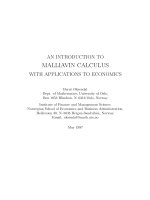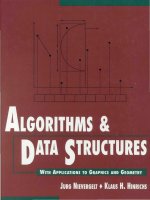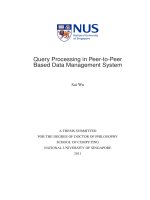Big data processing with peer to peer architectures
Bạn đang xem bản rút gọn của tài liệu. Xem và tải ngay bản đầy đủ của tài liệu tại đây (1.79 MB, 245 trang )
BIG DATA PROCESSING WITH
PEER-TO-PEER ARCHITECTURES
GOH WEI XIANG
B. Comp. (Hons), NUS; Dipl Ing., Télécom SudParis
A THESIS SUBMITTED FOR THE DEGREE OF
DOCTOR OF PHILOSOPHY
DEPARTMENT OF COMPUTER SCIENCE
NATIONAL UNIVERSITY OF SINGAPORE
2014
“Tell me, Sir Samuel, do you know the phrase ‘Quis custodiet ipsos
custodes?’?”
It was an expression Carrot has occasionally used, but Vimes was not in
the mood to admit anything, “C an’t say that I do, sir”, he said. “Something
about trifle, is it?”
“It means ‘Who guards the guards themselves?’ Sir Samuel.”
“Ah.”
“Well?”
“Sir?”
“Who watches the Watch? I wonder?”
“Oh, that’s easy, sir. We watch one another.”
“Really? An intriguing point. . . ”
– Terry Pratchett, Feet of Clay
Declaration
I hereby declare that this thesis proposal is my original work and it has
been written by me in its entirety. I have duly acknowledged all the
sources of information which have been used in the thesis proposal.
This thesis proposal has not been submitted for any degree in any
university previously.
Goh Wei Xiang
18 June 2014
ii
Acknowledgements
Nanos gigantium humeris insidentes.
I stand on the shoulders of giants in hope that one day, I too
may provide the leg-up for those who come after. To the titans
before me, I can only offer, for now, my words of gratitude:
I would like to thank Ms. Toh Mui Kiat, Ms. Loo Line Fong,
Ms. Agnes Ang Hwee Ying, Mr. Bartholomeusz Mark Christo-
pher, Ms. Irene Ong Hwei Nee and all the other management
staffs for the administrative support; the endless correspondence
of emails makes the world go round.
I would like to thank the entire Technical Services team for clear-
ing up the mess when I screwed up the various systems one way
or another; allow me to salute the unsung heroes of technical
support.
I would like to thank Prof. Khoo Siau Cheng for helping me when
I was in France and again when I came back; je vous remercie
infiniment.
I would like to thank Prof. Chan Chee Yong and Prof. Stéphane
Bressan for all the critical comments; t he hottest fire makes the
strongest steel.
I would like to thank Prof. Chin Wei Ngan for introducing me
to functional programming languages; this has led me to delve
into the abstract nonsense called Category Theory.
I would like to thank Prof. Ooi Beng Chin for introducing me
to the works of structured peer-to-peer overlays; your lectures
on Advanced Topics in Databases (CS6203) are the beginning of
this work.
Most importantly, I would like to sincerely thank Prof. Tan
Kian-Lee for . . . everything. Thank you, sir.
Lastly, on a personal side, I would like to thank, as well as
apologize to, my family — my father, mother and brother —
for their continual support in all aspects of my life so that I can
selfishly satisfy my personal indulgence in research work; some
words are easier written than said: thank you, and sorry.
Contents
Contents v
List of Figures xi
List of Symbols xiii
1 Introduction 1
1.1 Recent Developments . . . . . . . . . . . . . . . . . . . . . . 1
1.2 Desirable System Qualities . . . . . . . . . . . . . . . . . . . 15
1.3 Structured Peer-to-Peer Architectures . . . . . . . . . . . . . 21
1.4 Contributions . . . . . . . . . . . . . . . . . . . . . . . . . . 25
1.5 Organization . . . . . . . . . . . . . . . . . . . . . . . . . . 28
2 Related Work 31
2.1 Structured Peer-to-Peer Overlays . . . . . . . . . . . . . . . 31
2.2 MapReduce Frameworks . . . . . . . . . . . . . . . . . . . . 41
2.3 Summary . . . . . . . . . . . . . . . . . . . . . . . . . . . . 49
v
Contents
3 Scalability: Katana 51
3.1 Motivation . . . . . . . . . . . . . . . . . . . . . . . . . . . . 51
3.2 Programming Model . . . . . . . . . . . . . . . . . . . . . . 54
3.3 Model Realization . . . . . . . . . . . . . . . . . . . . . . . . 66
3.4 System Architecture . . . . . . . . . . . . . . . . . . . . . . 72
3.5 System Internals . . . . . . . . . . . . . . . . . . . . . . . . 75
3.6 Experimental Study . . . . . . . . . . . . . . . . . . . . . . . 84
3.7 Summary . . . . . . . . . . . . . . . . . . . . . . . . . . . . 95
4 Robustness: Hardened Katana 97
4.1 Motivation . . . . . . . . . . . . . . . . . . . . . . . . . . . . 97
4.2 Model of Fault-Tolerance . . . . . . . . . . . . . . . . . . . . 100
4.3 Robust Katana Operations . . . . . . . . . . . . . . . . . . . 110
4.4 Experimental Study . . . . . . . . . . . . . . . . . . . . . . . 121
4.5 Summary . . . . . . . . . . . . . . . . . . . . . . . . . . . . 125
5 Elasticity: EMRE 127
5.1 Motivation . . . . . . . . . . . . . . . . . . . . . . . . . . . . 127
5.2 Differences in Execution Environment . . . . . . . . . . . . . 129
5.3 Observations . . . . . . . . . . . . . . . . . . . . . . . . . . . 130
5.4 System Design . . . . . . . . . . . . . . . . . . . . . . . . . . 132
5.5 Elastic Job Execution . . . . . . . . . . . . . . . . . . . . . . 147
5.6 Experimental Study . . . . . . . . . . . . . . . . . . . . . . . 166
5.7 Summary . . . . . . . . . . . . . . . . . . . . . . . . . . . . 175
vi
Contents
6 Conclusion 177
Bibliography 181
A Group Theory 199
B Category Theory 209
vii
Summary
Recent developments in the realm of computer science have
brought about the introduction of, what some may classify as,
disruptive technologies into the peripheral of both researchers
and developers alike. In present-day academic and industrial
parlance, we frequently hear the mention of the adoption of the
Big Data paradigm, or the deployment with cloud computing,
or the NoSQL movement, or the use of the MapReduce frame-
work. While some may have their reservations on the novelty or
the longevity of these newly introduced concepts, their continual
widespread adoption in the industry undoubtedly indicates pre-
viously unsatisfied needs for c ertain systemic providence from
the software solutions of yesteryear. Three such desirable quali-
ties of a system architecture can be identified: massive horizon-
tal scalability, robust distributed processing, and elastic resource
consumption.
Currently, the predominant architecture adopted for modern
data processing system is that of the master/workers architec-
ture; the main rationale for this adoption is said to be for the
simplicity of the system design. However, it is perhaps prof-
itable to investigate more elaborated alternatives, especially if
systemic qualities may be enhanced as a result. Extrapolat-
ing from the desirables, it appears that structured peer-to-peer
(P2P) overlays present as a good match to the conditions estab-
lished by the industry. This thesis sets out to demonstrate the
feasibility of adopting a structured P2P overlay in the design of
modern data processing system such that some of the identified
systemic qualities may be magnified.
On horizontal scalability, work has been done to develop a gen-
eralized data processing framework, much like the MapReduce
framework except that the programming model and the system
architecture are completely decentralized. The Katana frame-
work builds on the algebraic structure exhibit by many struc-
tured P2P overlays to materialize its programming model, which
encompasses the expressiveness of the MapReduce programming
model. Experimental results indicate that the augmented ex-
pressiveness, coupled with the decentralization of control, pro-
vides performance improvement in execution over widely scaled
clusters.
In terms of robust processing, research has been conducted to in-
vestigate the incorporation of the decentralized fault-tolerance of
structured P2P overlays into modern data processing system. In
particular, the robust processing of the MapReduce framework
can be generalized into an abstract model of fault-tolerant pro-
cessing called the cover-charge protocol (CCP). The Katana
framework is extended to incorporate the CCP so as to render
its operations fault-tolerant. Experimental studies indicate that
the overhead incurred by the CCP for the operations in the ex-
tended Katana framework, called hardened Katana framework,
is comparable to, if not lesser than, that of the MapReduce
framework. Moreover, the robustness induced within hardened
Katana is derived directly from its decentralized architecture,
and not some external mechanism.
For the notion of elasticity, the feasibility of enhancing the elas-
ticity of the MapReduce execution by embedding a structured
P2P overlay into its execution architecture has been explored.
By deploying the elastic overlay over the worker sites, the pro-
cessing element of this new execution architecture, called Elastic
MapReduce Execution (EMRE), is able to stretch or shrink in
response to resource allocation, thus allowing elastic process-
ing without any changes to the exposed interface. Furthermore,
since the overlay also presents as a distributed index, the infa-
mous shuffle phase of MapReduce can be pipelined, resulting
to overall improvement in running times. In addition, simu-
lated progressive availability of resources in experiments shows
that EMRE has super ior capability to handle such a situation
as com pared to unmodified MapReduce.
List of Figures
2.1 Cayley graph for (Z
8
, +
8
) with the generating set S = {1, 2, 4}
(
2.1a) and a corresponding imperfect Chord topology (2.1b) 35
2.2 BATON with 13 sites and fingers of site (2, 3) . . . . . . . . 38
2.3 Example of bounded broadcast on Chord from site 0 . . . . 40
2.4 MapReduce system architecture . . . . . . . . . . . . . . . . 44
2.5 YARN architecture . . . . . . . . . . . . . . . . . . . . . . . 47
3.1 Example of type graph, data graphs and joint data graph . 57
3.2 Example execution of kata job for document length . . . . 61
3.3 System architecture of a processing site in the Katana frame-
work . . . . . . . . . . . . . . . . . . . . . . . . . . . . . . .
72
3.4 Max/Mean ratios of different Chord schemes under simula-
tion . . . . . . . . . . . . . . . . . . . . . . . . . . . . . . .
77
3.5 Identification of a spanning tree for a kata job . . . . . . . 80
3.6 Effects of virtual sites on spanning tree of a kata job . . . 83
3.7 Running times of Document-Length (N = cl ust e r size) . . . 88
xi
List of Figures
3.8 Data t ransfer rate of Document-Length (N = 16,SF = 64) . 89
3.9 Running times of Equi-Join (N = cluster size) . . . . . . . 90
3.10 Data transfer rate of Equi-Join (N = 16,SF = 64) . . . . . 92
3.11 Running times of Aggregation-Query (N = cl us te r size) . . 94
4.1 Example of cover, charge and delegation . . . . . . . . . 106
4.2 Rearrangement of the spanning tree of bounded broadcast . 115
4.3 Example of a secondary delegation . . . . . . . . . . . . . . 117
4.4 Normalized running tim es of Document-Length (N = 16,
SF = 64) upon site failure . . . . . . . . . . . . . . . . . .
123
4.5 Normalized running times of Equi-Join (N = 16, SF = 64)
upon site failure . . . . . . . . . . . . . . . . . . . . . . . .
124
5.1 Data t ransformation of MapReduce processing model . . . . 131
5.2 EMRE system components . . . . . . . . . . . . . . . . . . . 132
5.3 Maximum/Mean ratios of some structured P2P overlays . . 144
5.4 Order of processing of the partitions . . . . . . . . . . . . . 155
5.5 Running times for Word-Count . . . . . . . . . . . . . . . . 169
5.6 Effects of number of reducers for Word-Count . . . . . . . . 170
5.7 Running times for Inverted-Index . . . . . . . . . . . . . . . 171
5.8 Running times of Self-Join . . . . . . . . . . . . . . . . . . . 172
5.9 Running times for Adjacency-List . . . . . . . . . . . . . . . 174
xii
List of Symbols
Mathematical Symbols
N Natural number set, N {i | i ∈ Z, i ≥ 0}
R Real number set
Z Integer set, Z {. . . , −2, −1, 0, 1, 2, . . . }
Z
+
Positive integer set, Z
+
{i | i ∈ Z, i > 0}
Generic Functions
⌊·⌋ Floor function, ∀x ∈ R,
⌊x⌋ = max({i ∈ Z | i ≤ x})
P(S) Power set of S, P(S) {S
′
| ∀S
′
⊆ S}
max (x
1
, x
2
, . . . , x
n
) Multi-variable maximum function
min (x
1
, x
2
, . . . , x
n
) Multi-variable minimum function
arg min
x
f(x) Argument of the minimum of f(x)
Probability Notions
exp (λ) Exponential distribution with λ as the rate
parameter
xiii
List of Figures
Pr (X) Probability that event X occurs
CDF Cumulative distribution function
E(X) Expected value of the random variable X
Other Mathemtical Notations
G = (V, E) Graph G is an ordered pair of a set of vertices
V and a set of edges E
Type Notations
v :: T Variable v is of type T
[T ] A list/array of type T
(T
1
, T
2
) An ordered pair of type T
1
and T
2
T
1
→ T
2
A function mapping type T
1
to type T
2
xiv
Chapter 1
Introduction
1.1 Recent Developments
The perpetual acceleration in the growth of digital data handled has now
been, more or less, taken as an irrefutable fact in all academic and indus-
trial discussions in the database community; and it is r ightfully so. Gantz
and Reinsel
(2012) estimated that the size of all digital data created and
consumed in 2012 was about 2,837 exabytes and this number will double
1
approximately every two years from 2012 to 2020. It is believed that in 2012,
23% of the digital data created would be useful for analytics but only 3% was
captured and curated (
Gantz and Reinsel, 2012); even so, 11% of surveyed
data managers already reported to have petabyte-scale data stores (
McK-
endrick
, 2012) indicating that we have not yet experienced the full potential
of the continual digitalization of the world.
Devlin (2011) projected that
the compound annual growth rate (CAGR) of unstructured business data
1
It will not be surprising if the actual size exceeds this estimate; previously,
Gantz
et al. (2007) estimated that the size of the digital data created and consumed in 2010
should be 988 exabytes when it was actually about 1,227 exabytes based on actual find-
ings (
Gantz and Reinsel, 2012).
1
Section 1.1 Recent Developments
is about 60% while the CAGR of structured business data is projected to
be about one-third of that; therefore the b elow-par data acquisition also
indicates that data sources will become increasingly varied. Boosted by
such radical underlying change, there has been an unprecedented furor of
activities in the database community:
Paradigms challenged. Increasingly, we have witnessed the database com-
munity accepting revisions to well-established ideologies. For exam-
ple, the Atomicity-Consistency-Isolation-Durability (ACID) quadru-
plets have long been the fundamentals in database management for
assuring reliable data processing. In seeking to cope with wider ser-
vice demands,
Fox et al. (1997) were the first
2
to propose using soft
state and eventual consistency to augment availability but the idea
was not immediately well-received partly because it was deemed as an
antithesis to that of the ACID properties (
Brewer, 2012). It was until
Brewer (2000) explored this idea further with what is now known as
the Brewer’s Theorem (
Gilbert and Lynch, 2002) that the community
began to look into the consistency-versus-availability argument, thus
promoting the movement that advocates the relaxation of the ACID
properties at some levels in a system (
Cattell, 2011) . Currently, such
a school of t hought has become an legitimate consideration in main-
stream syst em designs (
Brewer, 2012).
Limits breached. The resources invested in handling data seem to mirror
its exponential growth such that yesterday’s limit becomes today’s
baseline. In May 2010, Facebook broke new ground by announcing
that it had deployed the then-largest single H adoop cluster consisting
2
Though the idea of eventual consistency has always been a des ign considera-
tion (
Saito and Shapiro, 2005) and was conceptualized as early as 1975 (Johnson and
Thomas, 1975).
2
Chapter 1 Introduction
of 2,000 nodes and 21 petabytes of storage (Borthakur, 2010). Just a
year later, there were at least 22 reported petabyte-scale clusters, of
which Yahoo! possessed the largest one, which consisted of a total of
42,000 nodes with about 200 petabytes of data (
Wong, 2013 ); Monash
(2011) estimated Yahoo!’s biggest single Hadoop cluster to be a little
over 4,000 nodes. In fact, across the board from 2010 to 2011, the av-
erage Hadoop cluster size rose fr om 60 nodes to 200 nodes (
Monash,
2011); adoption rate of Hadoop is also expected to double in the com-
ing years (
McKendrick, 2012).
Contexts evolved. As the world gets progressively digitalized, new envi-
ronmental contexts are injected into the mix of database researches.
Today, we talk about the concept of Internet of Things whereby ev-
ery physical object may have a virtual representation on the Inter-
net (
Atzori et al., 2010). We experience an avalanche of social net-
working services (e.g., Faceb ook, Twitter and Google+) where even
non-physical objects (e.g., personal relationships, human conditions
and social community) may have virtual representations on the In-
ternet. Furthermore, mobile computing have progressed to the point
that, virtual presences on the Internet never cease and may be per-
petually on-the-move. Uncovering these uncharted lands have brought
about new foci of research in the database community (e.g.,
Aggarwal
et al.
, 2013 ; Fernando et al., 2013; King et al., 2009).
While the sheer size of digital data has a direct impact on database de-
velopments, the latter also positively affects the former in return, creating
the virtuous (perhaps vicious
3
) cycle of digitalization. Equipped with better
data engineering and more sophisticated processing tools, not only the limit
3
Just kidding.
3
Section 1.1 Recent Developments
on the size of managed data is lifted, the utility of data as deemed by the
industry is also expanded, thus promoting the interest in further digitalizing
information of all types. This is evident in that 19% of surveyed data man-
agers indicated that already 25% or more of their data is unstructured (i.e.,
not trivially relational) and 65% of the respondents further confirm that the
amount of unstructured data is expected to increase (
McKendrick, 2012).
Such is the perpetual dynamics on this commodity that we call “data”.
Set in such a volatile backdrop, new ideas are continually being introduced
into the landscap e; there are some concepts, or buzzwords as some may
prefer, that consistently come to attention. In the parlance of database, we
frequently hear about the mention of the adoption of the Big Data par adigm,
or the deployment with cloud computing, or the NoSQL movement, or the
use of the MapReduce framework. Being rather novel, these concepts actu-
ally do not yet have globally-accepted definitions. As such, these concepts
tend t o have overlapping jurisdiction whenever they are brought up. To
make matters worse, many refer to some of them as synonymous while oth-
ers may deem a couple of them to be encompassing the others. While it may
be pointless, and certainly futile, at this point, to try to give these concepts
exact formal definitions, it is worthwhile to investigate the raison d’être of
their frequent co-occurrences in the discussion of database as a prelude to
the presentation of some desirable qualities of t he architecture of a modern
data processing system
4
.
1.1.1 Big Data
Dealing with limit-breaking volume of data is not a novel theme; ever since
the invention of direct-access storage in the 1960s, computer scientists have
4
The term data processing system is used to refer collectively to any system that is
devised to perform some form of data processing.
4
Chapter 1 Introduction
been pre-occupied with the management of ever-increasing data size. Then,
Codd (1983) introduced in his seminar paper the groundbreaking concept
of the relational data model, which basically requires that all information
in a database be cast in terms of values in relations. Such formal and
yet simple approach to data management sparked the mass adoption of
relational database management systems in the industry. From then, the
relational model remains the most fundamental model in the commerce of
data. Though other alternatives (e.g., graph model and object model) or
extensions (e.g., object-relational model) had been introduced, the under-
lying concept of mainstream database seems to be extracting some form of
structure as a mean to manage and to process data. Thus, for some rela-
tional purists, it is blasphemy to accept revisions to such a time immemorial
concept and yet current trends seem to be proposing precisely that.
Given that computer scientists have somehow always been dealing with data
size that is too large, the fact that the adjective “big” is assigned to this par-
ticular paradigm does suggest certain degree of grandeur to the scale of data
in question. Indeed, as previously mentioned, the data currently handled is
already of petabyte-scale while, at the time of writing, the largest magnetic
disk drives remain in the terabytes range. Moreover, the CAGR of the disk
areal densities is projected to be about 19% from 2011 t o 2016 (Fang, 2012)
while the CAGR for data is projected to be 53% over the same period (
Nad-
karni and DuBois
, 2013). If data size is the only issue, then the entire Big
Data paradigm could have been resolved with a distributed storage solution;
however, the changes do involve other dimensions that challenge traditional
data management tools, particularly when the operations go beyond storage
and r etrieval (i.e., data analytics).
Typical description of the Big Data paradigm begins by identifying N “V-
5
Section 1.1 Recent Developments
word” dimensions, where N ≥ 3; each dimension measures one aspect of
the data handled such that the current state of digitalization is represented
by the perpetual augmentation along all the axes. As expected, one of the
dimensions cited is always volume, depicting the growth the data generated.
The basic three dimensions (Douglas, 2012) definition also includes veloc-
ity, depicting speed of data generation, and variety, depicting the growth of
unstructured data. Other definitions include dimensions such as variability
(variance in meaning, in lexicon), value (industrial benefits), veracity (de-
gree of correctness) and visualization (importance of graphical aggregation).
However, given the unbounded extent of interest, trying to classify Big Data
from a data-centric approach is almost like trying to know the “unknown
unknowns”
5
. Instead it may be easier classify the novel industrial needs so
as to understand the scope of Big Data.
Cohen et al. (2009) identified three
new aspects of data management and processing: magnetic, agile and deep
(MAD). The authors intended them to be used to classify the skills set of a
modern data analyst but when inversely applied, they also happen to be a
succinct classification of the current industrial needs:
Magnetic sourcing. Due to the structured mentality towards data man-
agement, traditional data warehouses have an inclination towards pro-
cessing “clean” data; thus in contrast, unstructured or semi-structured
data has poor affinity under these systems. However, as evident in re-
cent trend, regardless of causality, unstructured data is the principal
driver of data growth; therefore, modern data management needs to
be magnetic in that it should be able to attract and accommodate
these “uncleaned” data sources.
5
As in the (in)-famous “There are known knowns”-speech made by then United States
Secretary of Defense, Donald Rumsfeld in 2002.
6
Chapter 1 Introduction
Agile processing. Traditional data analysis requires elaborate resource
planning that may take multi-months preparation. Given that data
acquisition gets increasingly fast (note the velocity dimension) and
varied (note the variety dime nsion), such sophisticated design and
planning phase may no longer be applicable in mission-critical data
analysis for ad hoc decision making. Thus, modern data analytics have
to be more agile to adapt to the rapid pace of changes; in particular,
there is advantage now for data preparation to be kept minimal.
Deep analytics. With the expanded data sources, which are also increas-
ingly more varied, data analytics have correspondingly become more
sophisticated, possibly beyond that of traditional online analytics pro-
cessing (OLAP) and data cube operations (e.g., slice, dice, roll-up).
Such deeper analytics are often beyond the assistance of structure ex-
tractions and pre-computations. Furthermore, the excessive volume of
data being analyzed makes deeper analytics particularly challenging.
The advent of relational database management systems promoted activities
of business intelligence to center around the structuring of data. However,
while the data model and the supporting computer system may be scaled
to encompass the Big Data paradigm, the surrounding human activities
already seem to be bursting at the seams; after all, it is well-known that hu-
mans are not scalable. All three aspects of the MAD classifications actually
challenge precisely the “human”-aspect of the data analytics, thus providing
considerable legitimacy to the revision suggested by the Big Data paradigm.
1.1.2 Cloud Computing
Cloud computing is perhaps the most fuzzily defined among all the recently
popularized concepts. One reason for such ambiguity may be due to the fact
7
Section 1.1 Recent Developments
that similar or related notions have always been in development throughout
the history of computer science. Each of these notions has now somehow
become associated with cloud computing in one way or another. Some of
the preceding developments include the following:
Utility computing. The most ancient notion of cloud computing m ost
likely comes from the suggestion of utility computing by John Mc-
Carthy in 1961 (
Garfinkel, 1999). The basic philosophy is to let com-
putational resources be available under a “pay-per-use” basis much
like public utility; the intention is to maximize their productivity.
The feasibility of such a concept lies in the economies of scale and the
exploitation of shared services via resource scheduling. Since then,
computer science researchers have come a long way to materialize this
vision to some extent with the current state of cloud computing.
On-demand services. The nomenclature of cloud computing frequently
includes various “-as-a-service” hosted software architectures of dif-
ferent abstractions (e.g., platform-as-a-service, software-as-a-service,
database-as-a-service) (
Sakr et al., 2011). The basic idea is to apply
the principle of separation of concern (
Dijkstra, 1982) at the enter-
prise level such that various aspects of a system may be hosted by
external service providers; this may be considered in some ways as
utility computing being conducted at the enterprise level. Despite the
common association with cloud computing, on-demand services actu-
ally predate that of cloud computing; as early as 2001, the industry
of application service providers (ASP) is already a multi-billion dollar
market (
Tao, 2001), indicating that outsourcing of part of a system
has been well incorporated into enterprise practices. Perhaps the ex-
8
Chapter 1 Introduction
periences of ASPs serve indirectly as a lead-in for cloud computing in
terms of architectural integration and system implementation.
Distributed computing. Any study of processing and operations within
a networked system can be considered as distributed computing, thus
distributed computing is actually a very mature area of research. And
in recent years, this field seems to have become the centerpiece of
all computing disciplines. The main contributing factor for this phe-
nomenon may very well be simply necessity due to the massive amount
of data to be handled in operation (
Sakr et al., 2011). Facing data
size of limit-breaking scale, parallel solutions offer performance match-
up where sequential ones fall short. Perhaps, this is the reason for
the frequent tie-in between distributed computing and the Big Data
paradigm. As cloud computing is deployed over an array of commod-
ity servers (i.e., horizontal scaling), its operations are almost definitely
based on some distributed solutions. Therefore, a cloud system may
be deemed as a very large manifestation of distributed computing.
The above mentioned notions are by no means an exhaustive listing of all
that is related to cloud com puting. Nevertheless, it is noteworthy to indi-
cate that it is the nature of cloud computing to seek to encompass all these
notions and thus share their philosophies. Also, the descriptions are merely
high-level gross overviews of the subject matter; part of the importance
of cloud computing is the innumerable amount of details, be it technical,
economical or even legal, that comes into play to bear fruit to the cloud
computing that we know of. Notable critical technological improvements
that catalyzed the development of cloud computing include improvements
in hardware virtualization (Manohar, 2013), adoption of service-oriented
9




![data visualization with flash builder [electronic resource] designing ria and air applications with remote data sources](https://media.store123doc.com/images/document/14/y/tf/medium_tfh1401469892.jpg)




